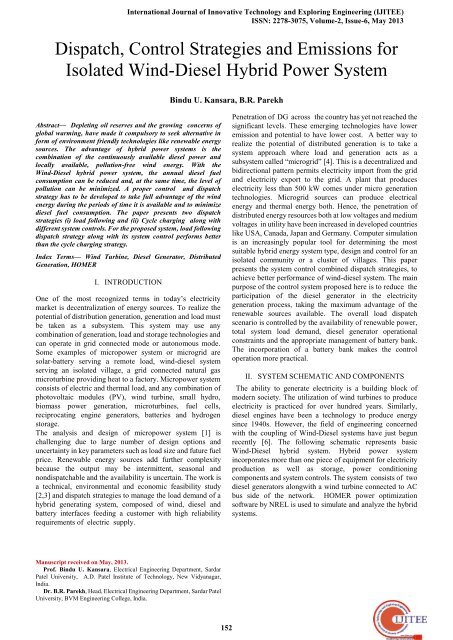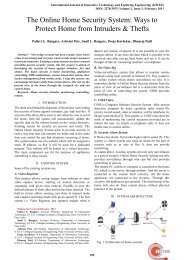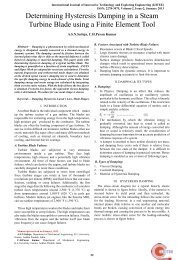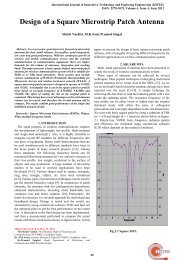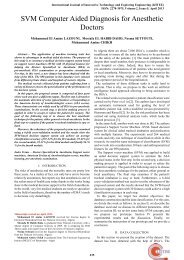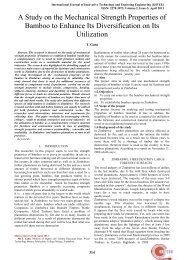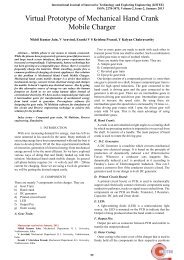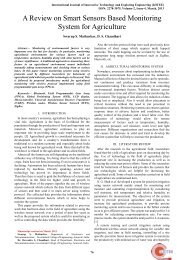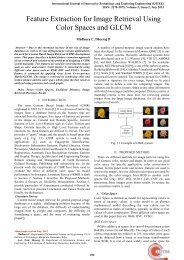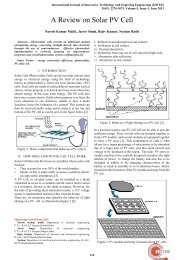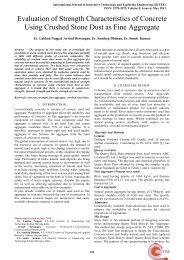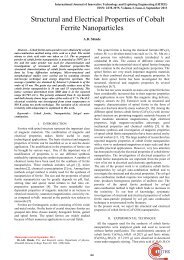Dispatch, Control Strategies and Emissions for Isolated Wind-Diesel ...
Dispatch, Control Strategies and Emissions for Isolated Wind-Diesel ...
Dispatch, Control Strategies and Emissions for Isolated Wind-Diesel ...
Create successful ePaper yourself
Turn your PDF publications into a flip-book with our unique Google optimized e-Paper software.
International Journal of Innovative Technology <strong>and</strong> Exploring Engineering (IJITEE)ISSN: 2278-3075, Volume-2, Issue-6, May 2013<strong>Dispatch</strong>, <strong>Control</strong> <strong>Strategies</strong> <strong>and</strong> <strong>Emissions</strong> <strong>for</strong><strong>Isolated</strong> <strong>Wind</strong>-<strong>Diesel</strong> Hybrid Power SystemBindu U. Kansara, B.R. ParekhAbstract— Depleting oil reserves <strong>and</strong> the growing concerns ofglobal warming, have made it compulsory to seek alternative in<strong>for</strong>m of environment friendly technologies like renewable energysources. The advantage of hybrid power systems is thecombination of the continuously available diesel power <strong>and</strong>locally available, pollution-free wind energy. With the<strong>Wind</strong>-<strong>Diesel</strong> hybrid power system, the annual diesel fuelconsumption can be reduced <strong>and</strong>, at the same time, the level ofpollution can be minimized. A proper control <strong>and</strong> dispatchstrategy has to be developed to take full advantage of the windenergy during the periods of time it is available <strong>and</strong> to minimizediesel fuel consumption. The paper presents two dispatchstrategies (i) load following <strong>and</strong> (ii) Cycle charging along withdifferent system controls. For the proposed system, load followingdispatch strategy along with its system control per<strong>for</strong>ms betterthan the cycle charging strategy.Index Terms— <strong>Wind</strong> Turbine, <strong>Diesel</strong> Generator, DistributedGeneration, HOMERI. INTRODUCTIONOne of the most recognized terms in today’s electricitymarket is decentralization of energy sources. To realize thepotential of distribution generation, generation <strong>and</strong> load mustbe taken as a subsystem. This system may use anycombination of generation, load <strong>and</strong> storage technologies <strong>and</strong>can operate in grid connected mode or autonomous mode.Some examples of micropower system or microgrid aresolar-battery serving a remote load, wind-diesel systemserving an isolated village, a grid connected natural gasmicroturbine providing heat to a factory. Micropower systemconsists of electric <strong>and</strong> thermal load, <strong>and</strong> any combination ofphotovoltaic modules (PV), wind turbine, small hydro,biomass power generation, microturbines, fuel cells,reciprocating engine generators, batteries <strong>and</strong> hydrogenstorage.The analysis <strong>and</strong> design of micropower system [1] ischallenging due to large number of design options <strong>and</strong>uncertainty in key parameters such as load size <strong>and</strong> future fuelprice. Renewable energy sources add further complexitybecause the output may be intermittent, seasonal <strong>and</strong>nondispatchable <strong>and</strong> the availability is uncertain. The work isa technical, environmental <strong>and</strong> economic feasibility study[2,3] <strong>and</strong> dispatch strategies to manage the load dem<strong>and</strong> of ahybrid generating system, composed of wind, diesel <strong>and</strong>battery interfaces feeding a customer with high reliabilityrequirements of electric supply.Penetration of DG across the country has yet not reached thesignificant levels. These emerging technologies have loweremission <strong>and</strong> potential to have lower cost. A better way torealize the potential of distributed generation is to take asystem approach where load <strong>and</strong> generation acts as asubsystem called “microgrid” [4]. This is a decentralized <strong>and</strong>bidirectional pattern permits electricity import from the grid<strong>and</strong> electricity export to the grid. A plant that produceselectricity less than 500 kW comes under micro generationtechnologies. Microgrid sources can produce electricalenergy <strong>and</strong> thermal energy both. Hence, the penetration ofdistributed energy resources both at low voltages <strong>and</strong> mediumvoltages in utility have been increased in developed countrieslike USA, Canada, Japan <strong>and</strong> Germany. Computer simulationis an increasingly popular tool <strong>for</strong> determining the mostsuitable hybrid energy system type, design <strong>and</strong> control <strong>for</strong> anisolated community or a cluster of villages. This paperpresents the system control combined dispatch strategies, toachieve better per<strong>for</strong>mance of wind-diesel system. The mainpurpose of the control system proposed here is to reduce theparticipation of the diesel generator in the electricitygeneration process, taking the maximum advantage of therenewable sources available. The overall load dispatchscenario is controlled by the availability of renewable power,total system load dem<strong>and</strong>, diesel generator operationalconstraints <strong>and</strong> the appropriate management of battery bank.The incorporation of a battery bank makes the controloperation more practical.II. SYSTEM SCHEMATIC AND COMPONENTSThe ability to generate electricity is a building block ofmodern society. The utilization of wind turbines to produceelectricity is practiced <strong>for</strong> over hundred years. Similarly,diesel engines have been a technology to produce energysince 1940s. However, the field of engineering concernedwith the coupling of <strong>Wind</strong>-<strong>Diesel</strong> systems have just begunrecently [6]. The following schematic represents basic<strong>Wind</strong>-<strong>Diesel</strong> hybrid system. Hybrid power systemincorporates more than one piece of equipment <strong>for</strong> electricityproduction as well as storage, power conditioningcomponents <strong>and</strong> system controls. The system consists of twodiesel generators alongwith a wind turbine connected to ACbus side of the network. HOMER power optimizationsoftware by NREL is used to simulate <strong>and</strong> analyze the hybridsystems.Manuscript received on May, 2013.Prof. Bindu U. Kansara, Electrical Engineering Department, SardarPatel University, A.D. Patel Institute of Technology, New Vidyanagar,India.Dr. B.R. Parekh, Head, Electrical Engineering Department, Sardar PatelUniversity, BVM Engineering College, India.152
<strong>Dispatch</strong>, <strong>Control</strong> <strong>Strategies</strong> <strong>and</strong> <strong>Emissions</strong> <strong>for</strong> <strong>Isolated</strong> <strong>Wind</strong>-<strong>Diesel</strong> Hybrid Power Systemcombination to its rated capacity, or as close as possiblewithout causing excess electricity.If a setpoint state of charge is applied to the cycle chargingstrategy, then when the battery state of charge is below thesetpoint <strong>and</strong> the battery was not discharging in the previoustime step, HOMER will avoid discharging the battery in thistime step. A generator will likely be called upon to serve theprimary load <strong>and</strong> produce excess electricity to charge thebattery bank. So once the system starts charging the batterybank it continues to do so until it reaches the setpoint state ofcharge.C. System <strong>Control</strong>s :Multiple generators can operate simultaneously, withminimum renewable energy fractions (MRF) considered =0% <strong>and</strong> 20%, annual interest rate = 6%, plant working lifespan = 20 years, diesel price =0.8$/L, wind speed = 0, 4.5 <strong>and</strong>5.5 m/sV. RESULTS AND DISCUSSIONThe system shown in figure 4 is simulated <strong>for</strong> two differentdispatch strategies with the system controls. Table 1 showsthe comparison of load following <strong>and</strong> cycle charging dispatchstrategies.The system is simulated <strong>for</strong> load following <strong>and</strong> cycle chargingwith SOC 80%, the analysis is carried out consideringtechnical, electrical <strong>and</strong> environmental aspects. With theproposed system control <strong>and</strong> dispatch strategies, Table 1shows the per<strong>for</strong>mance of the system with load followingstrategy is better than that of cycle charging dispatch.[6] Shahid S. M., El-Amin I, Ahmed F., “Potential of Off-Grid<strong>Wind</strong>/<strong>Diesel</strong> hybrid System <strong>for</strong> Electrification of a remote Settlementin Saudi Arabia” <strong>Wind</strong> Engineering, 28 (5) , 621-628, 2004.[7] Frye Jack A. “Per<strong>for</strong>mance Objective Design of a <strong>Wind</strong>-<strong>Diesel</strong> HybridEnergy System <strong>for</strong> Scott Base, Antarctica”, Master’s Thesis, 2006.[8] http://www.academia.edu/1485012/<strong>Dispatch</strong>_Strategy_<strong>and</strong>_Model_<strong>for</strong>_Hybrid_Photovoltaic_<strong>and</strong>_Trigeneration_Power_Systemsaccessed on 12 March, 2013[9] J.K. Kaldellis, An integrated model <strong>for</strong> per<strong>for</strong>mance simulation ofhybrid wind–diesel systems Renewable Energy 32 (2007) 1544–156science direct[10] Survey on Microgrid <strong>Control</strong> <strong>Strategies</strong> Wei Huanga, Miao Lua*, LiZhangb elsevierProf. Bindu U. Kansara is with Department of Electrical Engineering, A.D.Patel Institute of Technology, New Vallabh Vidyanagar. She has completedher Bachelor <strong>and</strong> Master degree in Electrical Engineering from BirlaVishvakarma College of Engineering, Gujarat, India. She is currentlypursuing Ph.D. Her research interest includes Microgrid, DistributedGeneration <strong>and</strong> Power System Operation <strong>and</strong> <strong>Control</strong>, Renewable EnergyResources.Dr. B. R. Parekh is Professor <strong>and</strong> Head of Department of ElectricalEngineering, BVM Engineering College, Vallabh Vidyanagar, Gujarat,India. He has completed his BE <strong>and</strong> ME in Power System. He has completedhis Ph.D. from IIT, Bombay with specialization in power system. He haspublished number of papers in national <strong>and</strong> international journals. Hisresearch interest includes HVDC transmission systems, Power SystemOperation <strong>and</strong> <strong>Control</strong>.VI. CONCLUSIONThe results of isolated <strong>Wind</strong>-diesel hybrid system usingHOMER modeling shows that if, cost summary, cash flowsummary, electrical production or emissions <strong>and</strong> cost of windturbine, battery <strong>and</strong> converter us considered as a whole, loadfollowing dispatch strategy is far better than cycle chargingdispatch strategy. Considering economic, technical <strong>and</strong>environmental aspects <strong>for</strong> both the strategies, Load followingstrategy is better in cases where renewable penetration is more<strong>and</strong> cycle charging is effective in cases where renewableenergy penetration is less. For this hybrid wind-diesel system,load following dispatch strategy gives better per<strong>for</strong>mance interms of Net Present Cost (NPC), Cost of Energy (COE),renewable fraction <strong>and</strong> GHG (Green House Gases) emissions.REFERENCES[1] Rocha M. da., L<strong>and</strong>a Noronha G., Paula Cardoso A. ,et. al. “Feasibilitystudy <strong>for</strong> Hybrid Electric Generating with <strong>Wind</strong>-<strong>Diesel</strong> <strong>and</strong> GridResources “ RIO 9 – World Climate <strong>and</strong> Energy Event , 17-19 March,2009, Brazil[2] Manwel J. F., McGowan J. G., Abdulwahid U., “SimplifiedPer<strong>for</strong>mance model <strong>for</strong> Hybrid <strong>Wind</strong>-diesel System” RenewableEnergy Laboratory, MA, USA.[3] BJindal A.K., Gole A.M., Muthumuni D., “Modeling <strong>and</strong> Per<strong>for</strong>manceAnalysis of an Integrated <strong>Wind</strong>/<strong>Diesel</strong> Power System <strong>for</strong> Off GridLocations,” 15 th National Power System Conference (NPSC), IITBombay, December 2008.[4] Lasseter R. H., Paigi P. “Microgrid : A Conceptual Solution”PESC’04, Germany, 20-25 June 2004[5] Getting Started Guide <strong>for</strong> HOMER Version 2.1, April 2005155
International Journal of Innovative Technology <strong>and</strong> Exploring Engineering (IJITEE)ISSN: 2278-3075, Volume-2, Issue-6, May 2013StartObtain <strong>Wind</strong> Speed Data <strong>for</strong> a particular locationEnter load data (i) Daily Profile <strong>and</strong> (ii) Seasonal ProfileSelect suitable sizes of <strong>Wind</strong> Turbine, <strong>Diesel</strong> Generator, Battery <strong>and</strong> ConvertorApply system control <strong>and</strong> dispatch strategy<strong>Isolated</strong> <strong>Wind</strong> – <strong>Diesel</strong> Hybrid SystemLoad FollowingCycle ChargingAnalyze the impacts of both dispatch strategies in terms ofEnvironmental, Technical <strong>and</strong> Economic AspectsParametersStopFigure 5 Flowchart of the Proposed System<strong>Dispatch</strong> <strong>Strategies</strong>Load FollowingCycle ChargingTotal net present cost (NPC) $ 5,732,866 $ 5,812,497Levelized cost of energy (COE) $ 0.574/kWh $ 0.582/kWhOperating cost $ 268,346/yr $ 274,576/yr<strong>Wind</strong> turbines 8,325,531 kWh/yr - 97% 8,325,531 96%Generator 1 73,499 kWh/yr -1% 70,729 1%Generator 2 215,000 kWh/yr - 2% 258,679 3%Renewable fraction 0.629 0.578Carbon dioxide 334,355 kg/yr 359,157 kg/yrCarbon monoxide 817 kg/yr 878 kg/yrUnburned hydocarbons 90.5 kg/yr 97.3 kg/yrParticulate matter 61.6 kg/yr 66.2 kg/yrSulfur dioxide 672 kg/yr 721 kg/yrNitrogen oxides 7,288 kg/yr 7,836 kg/yrTable : 1 Comparison of dispatch strategies <strong>for</strong> <strong>Wind</strong>-<strong>Diesel</strong>-Battery System156


